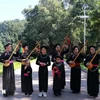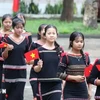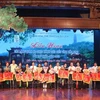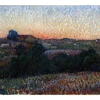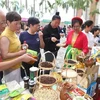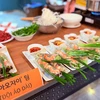 The famed terraced rice fields in Hoang Su Phi begin to brighten in the middle of September, signalling the start to a month-long harvest. Spanning across 11 communes of Hoang Su Phi, the fields were recognised as a national heritage site in September 2012. The fields are estimated to have been cut into the mountainside around 300 years ago by the La Chi, Dao and Nung ethnic groups. The harvest season in the district falls in September and October, creating a breathtaking scene that attracts tourists to Ha Giang province every autumn. There are two routes to Hoang Su Phi from Hanoi, one through Tuyen Quang province and the other through Lao Cai province, both around 300 kilometers long. (Photo: VietnamPlus)
The famed terraced rice fields in Hoang Su Phi begin to brighten in the middle of September, signalling the start to a month-long harvest. Spanning across 11 communes of Hoang Su Phi, the fields were recognised as a national heritage site in September 2012. The fields are estimated to have been cut into the mountainside around 300 years ago by the La Chi, Dao and Nung ethnic groups. The harvest season in the district falls in September and October, creating a breathtaking scene that attracts tourists to Ha Giang province every autumn. There are two routes to Hoang Su Phi from Hanoi, one through Tuyen Quang province and the other through Lao Cai province, both around 300 kilometers long. (Photo: VietnamPlus)  A view of the fields in Hoang Su Phi. The district typically serves as the final stop on harvest season tours through the northern mountainous provinces since the paddies here are often the last to turn. There are two ways to get to Hoang Su Phi: one begins in Hanoi and cuts through Tuyen Quang province, while the other snakes through Lao Cai province. Both routes cover around 300 kilometers. Travellers can either brave the roads on a motorbike or catch a bus to Hoang Su Phi. Most agree that the stunning views are worth the journey. Ha Giang province aims to make tourism a spearhead economic sector in 2030, turning into a key national tourist hub. (Photo: VietnamPlus)
A view of the fields in Hoang Su Phi. The district typically serves as the final stop on harvest season tours through the northern mountainous provinces since the paddies here are often the last to turn. There are two ways to get to Hoang Su Phi: one begins in Hanoi and cuts through Tuyen Quang province, while the other snakes through Lao Cai province. Both routes cover around 300 kilometers. Travellers can either brave the roads on a motorbike or catch a bus to Hoang Su Phi. Most agree that the stunning views are worth the journey. Ha Giang province aims to make tourism a spearhead economic sector in 2030, turning into a key national tourist hub. (Photo: VietnamPlus)  Along with the Dong Van Karst Plateau, Hoang Su Phi terraced rice fields are also among the tourist attractions of Ha Giang. They cover 11 communes in the northern province, comprising San Sa Ho, Ho Thau, Nam Ty, Thong Nguyen, Ta Su Choong, Ban Nhung, Po Lo, Thang Tin, Nam Khoa, Ban Luoc, and Ban Phung. They soar to their highest points in last two mentioned. The fields are estimated to have been cut into the mountainside around 300 years ago by the La Chi, Dao and Nung ethnic groups. During the harvest season the Hoang Su Phi terraces shine like gold, attracting many tourists and photographers and helping the poverty-stricken province of Ha Giang develop its tourism. (Photo: VietnamPlus)
Along with the Dong Van Karst Plateau, Hoang Su Phi terraced rice fields are also among the tourist attractions of Ha Giang. They cover 11 communes in the northern province, comprising San Sa Ho, Ho Thau, Nam Ty, Thong Nguyen, Ta Su Choong, Ban Nhung, Po Lo, Thang Tin, Nam Khoa, Ban Luoc, and Ban Phung. They soar to their highest points in last two mentioned. The fields are estimated to have been cut into the mountainside around 300 years ago by the La Chi, Dao and Nung ethnic groups. During the harvest season the Hoang Su Phi terraces shine like gold, attracting many tourists and photographers and helping the poverty-stricken province of Ha Giang develop its tourism. (Photo: VietnamPlus)  Autumn coats Hoang Su Phi district in the northern mountainous province of Ha Giang in a fairytale-like beauty, especially when its renowned terraced rice fields are dyed in a golden glow around September. The fields are estimated to have been cut into the mountainside around 300 years ago by the La Chi, Dao and Nung ethnic groups. Not only a masterpiece of nature, Hoang Su Phi terraced fields are also an example of the labour and creativity of local ethnic minorities. From the available natural conditions and long-established production practices, they have overcome natural difficulties to create terraced fields that stretch along the craggy mountain slopes. (Photo: VietnamPlus)
Autumn coats Hoang Su Phi district in the northern mountainous province of Ha Giang in a fairytale-like beauty, especially when its renowned terraced rice fields are dyed in a golden glow around September. The fields are estimated to have been cut into the mountainside around 300 years ago by the La Chi, Dao and Nung ethnic groups. Not only a masterpiece of nature, Hoang Su Phi terraced fields are also an example of the labour and creativity of local ethnic minorities. From the available natural conditions and long-established production practices, they have overcome natural difficulties to create terraced fields that stretch along the craggy mountain slopes. (Photo: VietnamPlus)  When ripening rice turns terraced fields in Hoang Su Phi district into glossy gold carpets, tourists flock to the northwestern mountain region to admire the beauty of agriculture and nature and learn about the life and customs of the local ethnic people who create the terraced fields. Cultivating terraced fields are a farming method used in mountainous areas where there is little flat land for farming. Mountain sides are terraced and watered from nearby springs. Hoang Su Phi is a border district of Ha Giang province populated by different ethnic groups, including Tay, Nung and Mong. They create the most beautiful terraced fields in Vietnam. (Photo: VietnamPlus)
When ripening rice turns terraced fields in Hoang Su Phi district into glossy gold carpets, tourists flock to the northwestern mountain region to admire the beauty of agriculture and nature and learn about the life and customs of the local ethnic people who create the terraced fields. Cultivating terraced fields are a farming method used in mountainous areas where there is little flat land for farming. Mountain sides are terraced and watered from nearby springs. Hoang Su Phi is a border district of Ha Giang province populated by different ethnic groups, including Tay, Nung and Mong. They create the most beautiful terraced fields in Vietnam. (Photo: VietnamPlus)  It took hundreds of years to cover the mountain sides with terraced. Unlike Mu Cang Chai or Y Ty, the terraces in Hoang Su Phi (Ha Giang provinces) are steeper and more tottery. This makes the scene even more spectacular. The district is a popular destination for both domestic and foreign tourists who come to enjoy the breathtaking views of the mountain areas and the unique culture of the local people. In each season, Hoang Su Phi attracts tourists with a different landscape. In May, the beginning of the rainy season, farmers plow and flood terraced fields with their irrigation systems. During this period their fields looks like curved mirrors. As the rice grows, their fields are awash with various shades of green. (Photo: VietnamPlus)
It took hundreds of years to cover the mountain sides with terraced. Unlike Mu Cang Chai or Y Ty, the terraces in Hoang Su Phi (Ha Giang provinces) are steeper and more tottery. This makes the scene even more spectacular. The district is a popular destination for both domestic and foreign tourists who come to enjoy the breathtaking views of the mountain areas and the unique culture of the local people. In each season, Hoang Su Phi attracts tourists with a different landscape. In May, the beginning of the rainy season, farmers plow and flood terraced fields with their irrigation systems. During this period their fields looks like curved mirrors. As the rice grows, their fields are awash with various shades of green. (Photo: VietnamPlus)  Those stunning terraced fields are not just used to farm rice, but also fish. In fact, this mostly “hidden” vocation is done on a large scale, increasing incomes and alleviating poverty in the area. In Hoang Su Phi, there are a total of 3,570 hectares of terraced rice fields. The watered area makes up 500 hectares, but only 255 hectares of the terraced fields are utilized during the spring planting season. Therefore, Hoang Su Phi authorities have promoted the model of carp farming, generating stable incomes for each household. The farmers usually release the fish into the fields in June and catch them in September right before they reap the rice, when the terrace fields start to turn yellow. (Photo: VietnamPlus)
Those stunning terraced fields are not just used to farm rice, but also fish. In fact, this mostly “hidden” vocation is done on a large scale, increasing incomes and alleviating poverty in the area. In Hoang Su Phi, there are a total of 3,570 hectares of terraced rice fields. The watered area makes up 500 hectares, but only 255 hectares of the terraced fields are utilized during the spring planting season. Therefore, Hoang Su Phi authorities have promoted the model of carp farming, generating stable incomes for each household. The farmers usually release the fish into the fields in June and catch them in September right before they reap the rice, when the terrace fields start to turn yellow. (Photo: VietnamPlus)  The rice terraces in Hoang Su Phi are among the top tourist attractions in Vietnam's northwestern region, together with those in Lao Cai province's Y Ty district and Yen Bai province's Mu Cang Chai district. Between September and October is the most beautiful time for photographers to take pictures. Terraced rice fields are brightly coloured in the harvest season, creating a breathtaking scene that attracts tourists to Ha Giang province every autumn. In the first six months this year, Ha Giang province attracted an estimated 642,000 tourists, and earned 1.157 trillion VND (50 million USD) from the tourism sector, competing 37.8 percent of the yearly plan. (Photo: VietnamPlus)
The rice terraces in Hoang Su Phi are among the top tourist attractions in Vietnam's northwestern region, together with those in Lao Cai province's Y Ty district and Yen Bai province's Mu Cang Chai district. Between September and October is the most beautiful time for photographers to take pictures. Terraced rice fields are brightly coloured in the harvest season, creating a breathtaking scene that attracts tourists to Ha Giang province every autumn. In the first six months this year, Ha Giang province attracted an estimated 642,000 tourists, and earned 1.157 trillion VND (50 million USD) from the tourism sector, competing 37.8 percent of the yearly plan. (Photo: VietnamPlus)  Located in the northern mountainous province of Ha Giang, Hoang Su Phi district is known for picturesque terraced fields spanning across 11 communes. The 3,000 hectares of terraces are said to be around 300 years old; the fruit of non-stop, creative labour by the Mong, La Chi, Dao and Nung ethnic minority groups. The magnificent terraced fields, one of the most beautiful landscapes in the whole country, were recognised as a national heritage site in September 2012. The district is a popular destination for both domestic and foreign tourists who come to enjoy the breathtaking views of the mountain areas and the unique culture of the local people. (Photo: VNA)
Located in the northern mountainous province of Ha Giang, Hoang Su Phi district is known for picturesque terraced fields spanning across 11 communes. The 3,000 hectares of terraces are said to be around 300 years old; the fruit of non-stop, creative labour by the Mong, La Chi, Dao and Nung ethnic minority groups. The magnificent terraced fields, one of the most beautiful landscapes in the whole country, were recognised as a national heritage site in September 2012. The district is a popular destination for both domestic and foreign tourists who come to enjoy the breathtaking views of the mountain areas and the unique culture of the local people. (Photo: VNA)  In each season, Hoang Su Phi attracts tourists with a different landscape. In May, the beginning of the rainy season, farmers plow and flood terraced fields with their irrigation systems. During this period their fields looks like curved mirrors. As the rice grows, their fields are awash with various shades of green. Between September and October is the most beautiful time for photographers to take pictures. Rice terrace fields are brightly coloured in the harvest season, creating a breathtaking scene that attracts tourists to Ha Giang province every autumn. Ha Giang has focused on developing various types of tourism to attract tourists, including the establishment of cultural, community-based tourism sites and homestays. (Photo: VietnamPlus)
In each season, Hoang Su Phi attracts tourists with a different landscape. In May, the beginning of the rainy season, farmers plow and flood terraced fields with their irrigation systems. During this period their fields looks like curved mirrors. As the rice grows, their fields are awash with various shades of green. Between September and October is the most beautiful time for photographers to take pictures. Rice terrace fields are brightly coloured in the harvest season, creating a breathtaking scene that attracts tourists to Ha Giang province every autumn. Ha Giang has focused on developing various types of tourism to attract tourists, including the establishment of cultural, community-based tourism sites and homestays. (Photo: VietnamPlus)  Located in northern Vietnam at an altitude of 1,000-1,600 metres above sea level, Ha Giang boasts dramatic landscapes and rich biodiversity. It is also home to numerous medicinal plants. Terraced rice fields in Hoang Su Phi are only some of the fascinating tourism attractions the province has to offer. Ha Giang is home to 19 ethnic minority groups that are steeped in cultural traditions, such as the Khau Vai Love Market, the ethnic Dao “cap sac” (coming-of-age) ritual, ethnic Pa Then flame dancing, the ethnic Tay “Long Tong” (field work) festival and the ethnic Lo Lo prayers for rain. Ha Giang aims to make tourism a spearhead economic sector in 2030. (Photo: VietnamPlus)
Located in northern Vietnam at an altitude of 1,000-1,600 metres above sea level, Ha Giang boasts dramatic landscapes and rich biodiversity. It is also home to numerous medicinal plants. Terraced rice fields in Hoang Su Phi are only some of the fascinating tourism attractions the province has to offer. Ha Giang is home to 19 ethnic minority groups that are steeped in cultural traditions, such as the Khau Vai Love Market, the ethnic Dao “cap sac” (coming-of-age) ritual, ethnic Pa Then flame dancing, the ethnic Tay “Long Tong” (field work) festival and the ethnic Lo Lo prayers for rain. Ha Giang aims to make tourism a spearhead economic sector in 2030. (Photo: VietnamPlus)  With rich cultural values and untouched natural beauty, Hoang Su Phi district has developed community-based and adventure tourism products, including trekking and homestays. So far, there are seven cultural villages being established and gained public attention in the district. Every year, the district authorities organise training workshops for local residents on sustainable tourism development. Hoang Su Phi district, with its stunning landscapes and distinctive cultural values, holds huge potential for ecotourism and community-based tourism. However, in order to bolster sustainable tourism in the locality, experts urge local authorities and relevant agencies to join hands in improving infrastructure and standardize tourism products. (Photo: VietnamPlus)
With rich cultural values and untouched natural beauty, Hoang Su Phi district has developed community-based and adventure tourism products, including trekking and homestays. So far, there are seven cultural villages being established and gained public attention in the district. Every year, the district authorities organise training workshops for local residents on sustainable tourism development. Hoang Su Phi district, with its stunning landscapes and distinctive cultural values, holds huge potential for ecotourism and community-based tourism. However, in order to bolster sustainable tourism in the locality, experts urge local authorities and relevant agencies to join hands in improving infrastructure and standardize tourism products. (Photo: VietnamPlus) VNA

